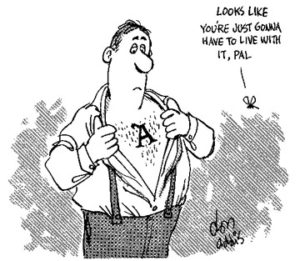Atheism as Speech Act: The Ex-Clergy Movement and Confessional Culture
Amy Levin: They say there’s a fine line between belief and non-belief, but for those whose job depends on that line, the difference is about as great as the distance from Jesus to, well, sin.
Amy Levin: They say there’s a fine line between belief and non-belief, but for those whose job depends on that line, the difference is about as great as the distance from Jesus to, well, sin. For those tired of hearing about nun-hating Catholic bishops, there’s a new collective of clergy stepping up to the soap box: atheist preachers. Other monikers taken from the headline goody bag include ex-preachers, non-believing clergy members, and doubting preachers. These emerging sinners are nothing like your neighborhood agnostic-queer-renewal-god-is-light rabbis. They’re more fallen-clergy-atheist-missionaries preaching the gospel of disbelief. Think of the “new atheists,” like the late Christopher Hitchens, and pretend he used to be a priest.
This trending topic of unbelieving proselytizers was kick-started by a 2010 study called “Preachers Who Are Not Believers” by Daniel C. Dennett and Linda LaScola, who set out to find and interview clergy members that were “closeted nonbelievers.” According to Greta Christina at Alternet, the report caught the attention of the sympathetic atheist community who quickly, with the financial backing of the Richard Dawkins Foundation for Reason and Science, created the Clergy Project in March 2011. Self-described as “a confidential online community for active and former clergy who do not hold supernatural beliefs,” the Clergy Project began with 52 members and now has over 290. The Clergy Project aims to support members with the following:
- Wrestling with intellectual, ethical, philosophical and theological issues
- Coping with cognitive dissonance
- Addressing feelings of being stuck and fearing the future
- Looking for new careers
- Telling their families
- Sharing useful resources
- Living as a nonbeliever with religious spouses and family
- Using humor to soften the pain
- Finding a way out of the ministry
- Adjusting to life after the ministry
Christina observes that more media attention and public “coming out” narratives escalated shortly after Teresa MacBain, a United Methodist pastor at the time, spoke at the American Atheists’ conference this past March in Bethesda, Maryland. Watch a video of MacBain’s confession here, where she ever-so-inspiringly pronounces, “My name is Teresa… I’m a pastor currently serving a Methodist church — at least up to this point–and I am an atheist.” Following the verbal protocol for AA introductions, MacBain’s dramatic confession seems ironically smug, both in its cultural mimicry and certainty of audience endorsement. She continues, “I was the one on the right track, and you were the ones that were going to burn in hell and I’m happy to say as I stand before you right now, I’m going to burn with you.” The crowd roars, MacBain cries, and the Devil is apparently welcomed into the room.
MacBain promotes herself as the first female graduate of the Clergy Project, runner-up to its first graduate, Jerry Dewitt, former Pentecostal minister and current executive director of Recovering from Religion, an organization with a promising tagline: “Thousands of organizations will help you get INTO religion, but we’re the only one helping you OUT.” Dewitt, MacBain, and several atheists in the Clergy Project share similar conversion narratives which include reasons like “religion’s inability to answer for or relive human suffering,” and the “failure” of religion to meet peoples’ needs. Many note the inefficacy of prayer. Conversion narratives, either “to” or “from” religion, are bound to harbor linguistic and experiential similarities. But there’s an additional quality to the ex-clergy-ers, the language of “coming out.” And it’s quite the pink elephant in the room.
The suggestive language of atheist preachers coming out of the religion closet/confessional booth often relies on the gay and lesbian “coming out” metaphor – the Clergy Project’s style, method, and emancipation-through-self-disclosure is strikingly (and somewhat militantly) like public pronouncements of non-heterosexual identities. Dan Merica, in his piece at CNN’s Belief Blog, “Unbelieving Preachers Get Help to ‘Come Out’ as Atheists,” gives us a taste of the Clergy Project’s model. First we have the safe online community, one in which DeWitt mustered up the “confidence to come out.” Then, Merica asks the question, “How does he feed his family?” This might come as a shock, but “outed” clergy members are often not welcomed back in their religious family with open arms and their vocational training doesn’t bode well for careers outside of the field. To help those suddenly without a community or profession, according to Merica, Recovering from Religion created a “Clergy Professional Relief Fund.” (I’ll just say it once: I wish the ex-clergy luck finding work in this economy, but I don’t exactly see them facing the same statistics from just a few years ago, when being gay was enough to get you fired in 30 states). Merica ends his piece with the section, “Losing Faith, Losing Friends,” in which DeWitt mourns the fact that many congregants and community members did not welcome his new beliefs with open arms.
Beyond the fact that overworking “coming out” in the ex-clergy movement is more-than-mildly-offensive to queer communities, there’s a more subtle, perhaps subconsciously strategic, reason why the DeWitt’s of the age fit so well in their strange bedfellows’ closet. The secular imaginary that posits a difference between believers and atheists is much like the sexual imaginary that posits an essential difference between gay and straight. In both, the image of the “real” or “essential” self is a cleaner, coherent, and purified version of the messy, ambiguous reality of religious and sexual identity. I can think of no better analysis of coming out than Eve Kosofsky Sedgwick’s Epistemology of the Closet. Sedgwick points to the ongoing debates over the essentialism versus constructivist arguments about homosexuality (a.k.a., nature/nurture), and allows us to question coming out as a speech act – an utterance in which saying is the same as doing, most quintessentially represented in the phrase/performance, “I do.” Or, I don’t know, perhaps the creation of the earth with a few Godly words might indicate our belief in the power of speech.
MacBain’s speech (act) at the American Atheists’ convention reads as a performance of identity through a de-confession of faith. And because we are all versed in the language of sexual identity and accept the coming out confession as real, MacBain successfully converts. Her atheism, like homosexuality, must be confessed, exposed, pronounced, and mediated through a verbal cue in order to make it real. Without this speech act, MacBain would be just another preacher, or wife, or woman with a myriad of identities and the constant possibility of becoming something else – even her “true” atheist self. And why wouldn’t she? If Freud was right about the talking cure, confessions make us sleep better at night.


